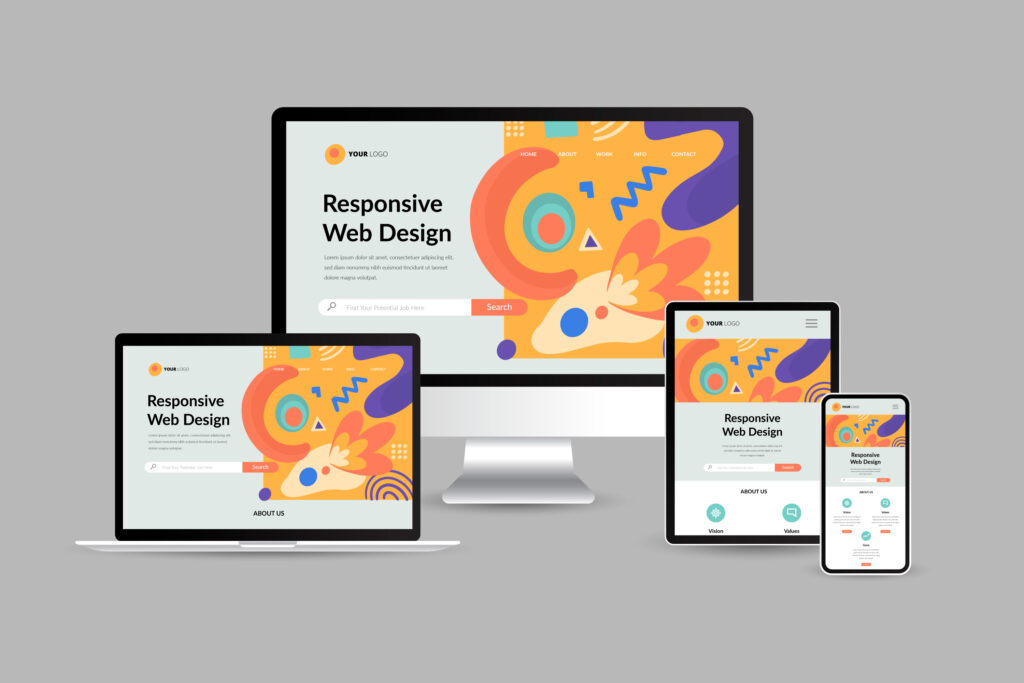
The role of UI/UX in digital marketing is pivotal for engaging users and driving conversions.
A seamless user interface (UI) combined with a captivating user experience (UX) and website design can significantly impact customer retention and brand loyalty. Understanding how UI/UX designs influence consumer behavior, website interaction, and overall satisfaction is crucial in today’s competitive digital landscape.
This blog post delves into the importance of incorporating effective UI/UX strategies to enhance digital marketing efforts, optimize conversion rates, and ultimately boost business success. Stay tuned to discover actionable insights on leveraging UI/UX principles for a successful digital marketing strategy.
Table of Contents
Key Takeaways
- Understanding UI and UX concepts is crucial for creating effective digital marketing strategies.
- The synergy between design and marketing is essential for delivering a seamless user experience.
- UI/UX plays a significant role in improving SEO performance by enhancing website usability and engagement.
- Prioritizing user-centric design principles can lead to higher customer satisfaction and conversion rates.
- Consistency and simplicity in UI/UX design contribute to brand recognition and user trust.
- Ensuring mobile responsiveness and accessibility is key to reaching a wider audience and improving user experience.
Decoding UI and UX Concepts

User Interface (UI)
User Interface (UI) design focuses on the look and feel of a digital product, emphasizing visual elements like colors, typography, and layout. UI design aims to create an aesthetically pleasing interface that enhances user experience.
Effective UI design ensures that users can easily navigate through a website or application. It includes elements such as buttons, menus, and other interactive components that guide users in interacting with the product seamlessly.
User Experience (UX)
User Experience (UX) design centers around the overall experience of a user when interacting with a digital product. UX design involves understanding user behaviors, needs, and motivations to create a seamless and enjoyable experience.
A key aspect of UX design is usability testing, where designers gather feedback from users to refine the product further. By prioritizing user needs and preferences, UX design aims to optimize the overall satisfaction of users.
User-Centered Design for Enhanced Engagement
A visually appealing user interface (UI) combined with intuitive user experience (UX) design, built on user-centered principles, is key to fostering user engagement.
When a website or application meets users’ expectations by offering a seamless experience that resonates with their needs and preferences, it captures their attention and encourages them to explore further.
This positive user experience translates to higher engagement levels, ultimately leading to increased customer satisfaction, retention rates, conversions, and brand loyalty.
Synergy Between Design and Marketing
Consistency & Brand Recognition
Designs play a crucial role in marketing efforts, contributing significantly to marketing success. When design consistency is maintained across various platforms, it fosters brand recognition among consumers. This recognition leads to repeat purchases and advocacy for the brand.
Maintaining a consistent design throughout all marketing materials, including websites, social media, and advertisements, helps reinforce the brand image in the minds of consumers. This consistency creates a sense of reliability and trustworthiness, which are essential for building long-term relationships with customers.

User Interface Enhancements
A well-designed user interface (UI) is vital for enhancing digital marketing strategies. A user-friendly interface ensures that potential customers can easily navigate through the website or app, leading to higher customer satisfaction levels. By making the design process intuitive and seamless, businesses can increase sales and conversions.
An optimized UI also considers the needs and preferences of the target audience, providing them with a personalized experience. This personalization not only enhances user satisfaction but also increases the likelihood of repeat purchases. Moreover, an intuitive UI streamlines the path to purchase, making it easier for customers to buy products or services.
Impact of UI/UX on SEO
Website Performance
User Interface (UI) and User Experience (UX) design significantly influence website performance and SEO. A well-designed website with intuitive navigation and a visually appealing layout tends to have lower bounce rates and higher user engagement. These factors contribute positively to search engine rankings.
Aesthetically pleasing websites that are easy to navigate enhance user experience, leading to longer dwell times and increased page views. Search engines like Google consider these metrics when determining the relevance and quality of a website’s content, which directly impacts its SEO performance.
User Engagement Metrics
UI/UX design plays a crucial role in shaping user engagement metrics such as time on site, pages per session, and conversion rates. When users find a website visually appealing and easy to use, they are more likely to explore multiple pages, spend more time on the site, and ultimately convert into customers or leads.
Interactive elements, clear calls-to-action, and seamless navigation contribute to a positive user experience, encouraging visitors to interact with the website’s content. These interactions signal search engines that the website provides value to users, thus improving its SEO ranking over time.
Bounce Rates and User Experience
High bounce rates, where visitors leave a website shortly after landing on it, can be detrimental to SEO performance. Poor UI/UX design often leads to high bounce rates as users get frustrated with slow loading times, confusing layouts, or lack of relevant information.

User-Centric Design Principles
Accessibility Optimization
Creating design elements that prioritize usability is crucial for optimizing user experiences. By focusing on user interactions and user behavior, designers can tailor interfaces to meet diverse needs. Incorporating features like alt text for images ensures accessibility for all users, including those with visual impairments.
Responsive Design Implementation
Implementing responsive design principles caters to the varied devices and platforms users engage with. Ensuring seamless transitions across desktop, mobile, and tablet interfaces enhances the overall customer experience. Prioritizing a smooth user journey regardless of the device boosts engagement and satisfaction levels.

Personalization Strategies
Tailoring interfaces based on user research and understanding user preferences elevates the overall digital marketing strategy. By analyzing user needs and behaviors, designers can create personalized experiences that resonate with the target audience. This level of customization helps address specific pain points and fosters stronger connections with users.
Consistency and Simplicity in UI/UX
Design Consistency
Consistent UI/UX elements across digital platforms contribute to a seamless user experience. When users encounter familiar design patterns, it enhances their navigation ease.
Maintaining consistency in color schemes, typography, and layout fosters a sense of reliability. Users are more likely to engage with interfaces that offer predictability in design elements.

Simplicity for Conversion Rates
A well-designed UI that prioritizes both simplicity and consistency is key to achieving both user satisfaction and high conversion rates.
A simple UI reduces cognitive load by eliminating unnecessary clutter and distractions, allowing users to navigate and make decisions swiftly. This focus on user-friendliness fosters a sense of trust and ease of use, which in turn cultivates positive emotions and encourages users to convert.
Additionally, maintaining consistency across design elements reinforces brand identity and builds credibility, leading to increased brand loyalty.
Mobile Responsiveness and Accessibility
Responsive Design
Responsive design ensures websites and digital products adapt to various devices. It plays a crucial role in enhancing user experience by providing consistency across platforms. This approach involves flexible layouts that adjust based on the screen size, enabling seamless navigation.
Implementing responsive design principles is essential for maximizing accessibility. By catering to different devices, websites can reach a wider audience and improve user engagement. This practice also contributes to reducing bounce rates, as users are more likely to stay on a site that is easy to navigate on any device.
Impact on User Experience
The impact of mobile responsiveness on user experience cannot be overstated. In today’s digital landscape, where users access content through various devices, ensuring accessibility is key. Websites that are not optimized for mobile devices may face higher bounce rates and lower conversion rates.
By prioritizing mobile responsiveness, businesses can enhance their digital experiences, leading to increased demand and conversions. A website that offers a seamless experience across devices is more likely to attract and retain customers. Moreover, search engines prioritize mobile-friendly sites, impacting search engine rankings positively.
Enhancing Accessibility
Ensuring accessibility across devices is vital for creating an inclusive digital environment. Users with disabilities rely on accessible websites to navigate and consume content effectively. Incorporating features such as alt text for images and keyboard navigation enhances the overall user experience.
Incorporating responsive design elements into e-commerce apps or websites can significantly impact customer satisfaction and loyalty. Users appreciate a consistent experience regardless of the platform they use, leading to higher conversion rates and improved retention rates.
Leveraging User Feedback for Design
Enhancing Design Decisions
User feedback plays a crucial role in shaping design decisions. By analyzing customer feedback, designers gain valuable insights into improving the overall experience of a website or application. This iterative process ensures that interactive elements are intuitive and user-friendly.
Continual enhancement based on feedback leads to a more refined product, ultimately boosting user satisfaction and engagement. Developers can identify pain points through usability testing and address them promptly, resulting in a seamless user experience. Incorporating user suggestions enhances the functionality of digital assets.

Impact on Brand Loyalty
User feedback significantly influences customer behavior, trust, and brand loyalty. Positive feedback can reinforce a customer’s impression of a brand, leading to increased trust and loyalty. On the other hand, addressing negative feedback promptly can turn dissatisfied customers into loyal advocates.
By actively seeking and implementing user feedback, brands demonstrate their commitment to meeting customer needs. This proactive approach fosters stronger relationships with customers, ultimately leading to higher retention rates and increased conversions.
Driving Conversions Through Feedback
Understanding how user feedback impacts brand perception is essential for driving conversions. Positive feedback can influence potential customers’ decision-making process, instilling confidence in the brand’s offerings. By listening to customer insights and making necessary iterations, brands can align their digital marketing strategies with customer preferences.
Incorporating user feedback into the design process not only enhances the overall user experience but also contributes to improved conversion rates. Brands that prioritize customer satisfaction by leveraging feedback are more likely to see an increase in conversion rates and long-term success.
User-Centric Design Success Stories
Quibi Success
Quibi, a short-form mobile video platform, focused on personalized experiences to cater to users’ preferences. By offering content in bite-sized episodes, Quibi ensured an effective UX. The platform’s quick and engaging format led to its success.
Apple’s User-Centric Approach
Apple is renowned for its commitment to providing a positive user experience through sleek design and intuitive interfaces. The company’s focus on simplicity and functionality has set the standard for world examples of exceptional UI/UX design.
Threadless Community Engagement
Threadless, a popular online T-shirt marketplace, thrives on user-generated content and community engagement. By involving customers in the design process, Threadless creates personalized experiences that resonate with its audience. This approach has yielded significant results in terms of customer loyalty and brand advocacy.
- Pros of Real-World UI/UX Success Stories:
- Inspire businesses to prioritize user-centric design.
- Showcase the impact of seamless UI/UX on customer satisfaction.
- Cons of Neglecting UI/UX Design:
- Risk losing customers due to poor navigation or confusing layouts.
- Miss out on opportunities for brand differentiation and customer retention.
Future Trends in UI/UX for Marketing
Personalized Experiences
Digital marketers are increasingly focusing on personalized experiences through UI/UX design to enhance customer engagement. By leveraging data analytics, companies can tailor marketing campaigns to individual preferences.
Creating customized content based on user behavior and interests ensures higher conversion rates and customer loyalty. This trend highlights the importance of intuitive interfaces and seamless user journeys in digital marketing efforts.
Augmented Reality Integration
The integration of augmented reality (AR) into UI/UX design is set to revolutionize digital marketing campaigns. AR technology offers interactive experiences that allow users to engage with products virtually before making a purchase decision.
According to Threekit, 61% of consumers express a preference for retailers offering augmented reality (AR) experiences.
By implementing AR features in their apps or websites, digital marketers can provide immersive brand experiences that drive customer engagement and boost sales. This innovative approach enhances user interaction and sets brands apart in a competitive market landscape.

Voice User Interfaces (VUI)
The adoption of voice user interfaces (VUI) is another emerging trend reshaping the future of UI/UX in digital marketing. VUI enables users to interact with devices using voice commands, offering a hands-free and convenient experience.
Integrating VUI into websites or applications simplifies user interactions, making it easier for customers to access information or make purchases. This trend caters to the growing demand for seamless, intuitive interfaces that prioritize user convenience and accessibility.
Closing Thoughts
The integration of UI/UX principles in digital marketing is crucial for enhancing user experiences and driving business success. By focusing on user-centric design, consistency, simplicity, and mobile responsiveness, companies can create compelling digital platforms that resonate with their target audience. Leveraging user feedback and staying abreast of future trends in UI/UX will further solidify a brand’s online presence and competitiveness.
To stay ahead in the digital landscape, businesses must prioritize the seamless fusion of design and marketing strategies. Embracing UI/UX best practices not only improves customer satisfaction but also boosts conversion rates and overall brand loyalty.
As technology continues to evolve, investing in innovative UI/UX approaches will be paramount for any organization aiming to thrive in the ever-changing digital marketing realm.
Related Article:
The following article may contain the author’s opinions and interpretations of the subject matter. Any of the products, services, or platforms mentioned is not sponsored or affiliated.
Featured Image courtesy of Freepik
